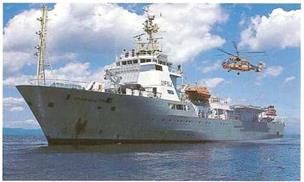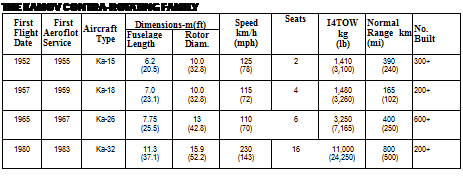Kamov Virtuosity



Contra-Rotation
Rather overshadowed by the preponderance of the Mil helicopters in service throughout the Soviet Union, and sometimes forgotten as world-wide interest tended to concentrate on the Mil giants (see pages 80-81), the generally smaller Kamovs deserve attention. Just as Mil perfected the techniques of single main rotor-plus-anti-torque tail rotor combinations, so did Nikolai Kamov solve the mechanical complexities of coaxial contrarotating main rotors, thus eliminating the need for any anti-torque device.
Getting under way with his first designs after the end of the Second World War, Kamov’s first light helicopters were for the Soviet Army, for observation and reconnaissance. But as time went on, opportunities for civilian use arose.
The Kamov Ka-15, Ka-18, and Ka-25
As with subsequent designs, the first effective Kamov helicopter, the Ka-15, first produced in 1952, had two contrarotating rotors, each with three blades. The Ka-15 demonstrated a brisk performance, and it went into service with Aeroflot in a variety of working roles: crop-spraying, powerline patrol, gas pipeline patrol, and ambulance work.
The slightly larger Ka-18 incorporated an improved fuselage structure, which was slightly longer, and with modified twin vertical stabilizers, but had the same rotors as the Ka-15. In the Ka-18, however, the rotor blades could easily be removed individually, and this made the aircraft especially useful for reconnaissance in the Arctic Ocean, where the convenience of storage space on the depot ships was at a premium.
A further stage of adaptability was achieved in the new Ka-25 which made its first appearance in 1961. This had the novel arrangement by which the individual rotor blades could be folded, under power, so as to be aligned together while not in use; such mechanical ingenuity was a great credit to the Kamov design team. Also, the Ka-25K featured a small cabin underneath the main flight deck. This contained a backwardfacing seat, for controlling operations when the helicopter was being used as a flying crane.
The Kamov Ka-26
All aircraft manufacturers have problems with reconciling conflicting requirements from different customers. In Kamov’s case, these appear to have been stringent demands for versatility both from the State Scientific Institute and from Aeroflot. The former wanted a helicopter that could out-per-
(Top) A Kamov Ka-32, on fish-spotting patrol, hovers over its depot ship, the Kherluf Bidstrup, in the Sea of Okhotsk.
(Bottom) Reminiscent of the Los Angeles freeways and the control thereof, this Kamov Ka-26 keeps an eye on the traffic in Vladivostok. (Vladimir Kuznetzov)
form the previous Kamovs in such activities as mapping, geological survey, fish-spotting, fire-fighting, and ice reconnaissance; Aeroflot needed one for normal passengers, mail, and freight, as well as for general agricultural use, and gas and oil pipeline patrolling. To quote John Stroud: "What Kamov produced was a most ingenious multi-purpose helicopter capable of almost any task except feeding itself."
The Kamov Ka-26 was larger than the Ka-15 and Ka-18 but smaller than the Ka-25. But it was far more efficient than any previous design. Like the Ka-25, it was twin-engined, but unlike it, the tail unit was supported by twin booms, rather than by an extension of the fuselage. Its unique feature was what can only be described as the come-apartness of the fuselage. The rear half of what would normally be a complete fuselage could be interchanged, according to the requirements: a small cabin for up to seven passengers, a pallet for cargo, or apparatus for crop-spraying, including a large hopper. This could spray dry chemicals as an alternative to liquid spraying throughout extended spray-bars, and the downwash of the rotors served to disperse the powder or granules in a uniform manner.
Later versions of the Ka-26 improved the performance and capability. The Ka-226, for example (fitted with Allison engines) could carry a chemical load of almost 1,000kg (compared with the 530kg of the Ka-26) on a 1 Уг-Іюиг mission, with full reserves.
Throughout the development of the versatile Kamovs, the accent was always on economy of operations — for even under the Soviet system, considerable accountability was often exercised. To borrow a sporting term, in this respect, the Kamov Ka-26 was the top seed.










